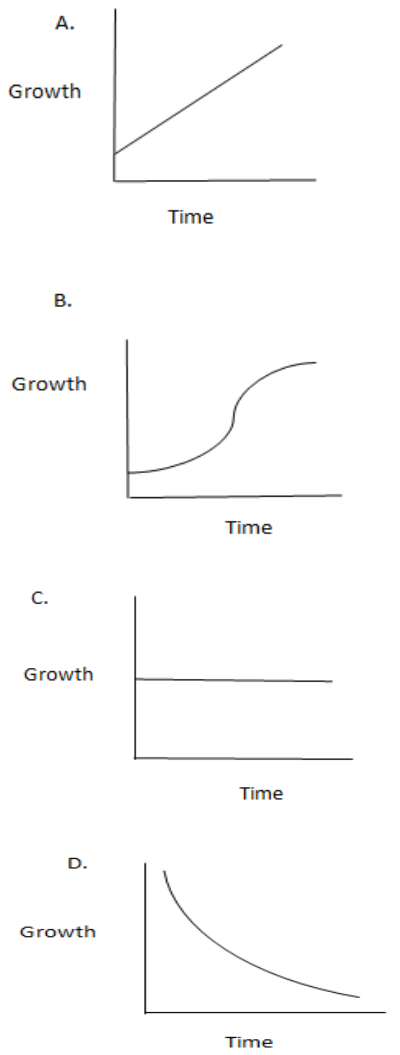
Which one is the correct graph for arithmetic growth?


Answer
447.6k+ views
Hint: Growth is defined as the steps involved in the development of an organism. It is the time from birth to the time of maturity or for some organisms to the time of death. It results from cellular multiplication, cell growth, cell expansion and also maturation.
Complete answer:
- Growth of an organism not only depends on internal signals but also external factors. The most important factor that affects growth is the availability of resources. When the resources are abundant growth occurs at a faster rate but when the resources become limiting the rate of growth also slows down.
- The rate of growth can be calculated by plotting a graph of growth vs time. Different organisms grow at different rates with time which has led to the formulation of four different types of growth- Arithmetic growth, Geometric growth, Sigmoid growth and Absolute growth. In Arithmetic growth the rate of growth is constant and growth occurs in an arithmetic progression.
- In Geometric growth the initial rate of growth is slow but it is followed by a rapid exponential rate. In Sigmoid growth the initial growth is slow, it is then followed by exponential growth, followed by stationary stage and finally a decline in growth. Absolute growth is the measurement of total growth per unit time.
Hence the correct answer is option A) which shows the graph for arithmetic growth.
Note: Growth is a very important step of development for all organisms without which they cannot survive. A knowledge about the different growth curves gives us an idea about the different forms of growth that different organisms undergo to survive and attain maturity.
Complete answer:
- Growth of an organism not only depends on internal signals but also external factors. The most important factor that affects growth is the availability of resources. When the resources are abundant growth occurs at a faster rate but when the resources become limiting the rate of growth also slows down.
- The rate of growth can be calculated by plotting a graph of growth vs time. Different organisms grow at different rates with time which has led to the formulation of four different types of growth- Arithmetic growth, Geometric growth, Sigmoid growth and Absolute growth. In Arithmetic growth the rate of growth is constant and growth occurs in an arithmetic progression.
- In Geometric growth the initial rate of growth is slow but it is followed by a rapid exponential rate. In Sigmoid growth the initial growth is slow, it is then followed by exponential growth, followed by stationary stage and finally a decline in growth. Absolute growth is the measurement of total growth per unit time.
Hence the correct answer is option A) which shows the graph for arithmetic growth.
Note: Growth is a very important step of development for all organisms without which they cannot survive. A knowledge about the different growth curves gives us an idea about the different forms of growth that different organisms undergo to survive and attain maturity.
Recently Updated Pages
Full Form of IASDMIPSIFSIRSPOLICE class 7 social science CBSE

In case of conflict between fundamental rights of citizens class 7 social science CBSE

Can anyone list 10 advantages and disadvantages of friction

What are the Components of Financial System?

Complete the letter given below written to your Principal class null english null

Express the following as a fraction and simplify a class 7 maths CBSE

Trending doubts
Who was Subhash Chandra Bose Why was he called Net class 10 english CBSE

Saptarishi is the Indian name of which Constellation class 10 social science CBSE

Complete the sentence with the most appropriate word class 10 english CBSE

Find the area of the minor segment of a circle of radius class 10 maths CBSE

Fill the blanks with proper collective nouns 1 A of class 10 english CBSE

List out three methods of soil conservation




